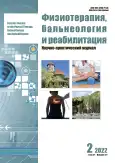INFLUENCE OF PHYSIOTHERAPY ON THE ELECTRICAL EXCITABILITY OF THE SHOULDER MUSCLES IN THE EARLY POSTOPERATIVE PERIOD AFTER RADICAL SURGICAL TREATMENT OF BREAST CANCER
- Authors: Evstigneeva I.1
-
Affiliations:
- Federal State Budgetary Educational Institution of Further Professional Education "Russian Medical Academy of Continuous Professional Education" of the Ministry of Healthcare of the Russian Federation
- Issue: Vol 21, No 2 (2022)
- Pages: 97-106
- Section: Original studies
- URL: https://journals.rcsi.science/1681-3456/article/view/108104
- ID: 108104
Cite item
Abstract
BACKGROUND. Combined treatment of cancer patients includes a large number of aggressive therapies that lead to a complex of functional disorders. There are no publications on the influence of physical factors on the electrical excitability of the muscles of the shoulder girdle and upper limb from the side of surgery in the early period after surgical treatment of breast cancer.
AIMS. To determine the physical factor that will most significantly affect the electrical excitability of the muscles of the shoulder girdle and upper limb on the side of the operation after radical surgical treatment of breast cancer.
MATERIAL AND METODS. A randomized, placebo-controlled study was conducted in 100 patients in the early postoperative period (2-4 days after surgery) for breast cancer. All patients underwent medical rehabilitation: individual physiotherapy exercises, balance therapy, sessions with a medical psychologist, physiotherapy treatment with a monofactor. Group 1 included 34 patients, the course of medical rehabilitation included fluctuorization, group 2 (n=33) included local magnetotherapy in the rehabilitation program, and group 3 (n=33) underwent general magnetotherapy procedures. Patients were examined for the excitability of the neuromuscular system using the ASEtM-01/6 "Elesculap Med TeCo" device.RESULTS. It was found that fluctuating currents turned out to be more effective in the early stages, which pathogenetically contribute to the restoration of conduction along the peripheral nerves and the activation and contractility of the muscle fiber. A delayed effect of local and general magnetic therapy on improving the contractility of the muscles of the upper limb and the conductivity of the peripheral nerve fiber was noted.
CONCLUSION. The inclusion of monophysical factors in the course of standard medical treatment, a course of physical therapy, exercises on a stabiloplatform and individual psychotherapy in the early stages (on days 2-4) after surgery contributed to the improvement in the functioning of the upper limb and the restoration of the electrical excitability of the muscles and nerves of the operated limb.
Full Text
##article.viewOnOriginalSite##About the authors
Inna Evstigneeva
Federal State Budgetary Educational Institution of Further Professional Education "Russian Medical Academy of Continuous Professional Education" of the Ministry of Healthcare of the Russian Federation
Author for correspondence.
Email: Evstigneevais@mail.ru
ORCID iD: 0000-0001-9128-0965
PhD; associat рrofessor
head of the department of physiotherapy of the clinic named after Professor Yu.N. Kasatkina Russian Federation
References
- REFERENCES
- Rak molochnoj zhelezy. Klinicheskie rekomendacii. 2020 [Rak molochnoi zhelezy. Klinicheskie rekomendatsii. 2020.. https://oncology-association.ru/files/clinical-guidelines-2020/Rak_molochnoj_zhelezy.pdf (In Russ.)
- Sostoyanie onkologicheskoj pomoshchi naseleniyu Rossii v 2020 godu. Pod redakciej A.D. Kaprina, V.V.Starinskogo, A.O. SHahzadovoj. M.: MNIOM im. P.A. Gercena – filial FGBU «NMIRC» Minzdrava Rossii. 2021. 239 (In Russ.)
- Yu Gui, Xunzhou Liu, Xianchun Chen, Xi Yang, Shichao Li, Qingwen Pan, Xiangdong Luo, Li Chen. A Network Meta-Analysis of Surgical Treatment in Patients With Early Breast Cancer. Journal of the National Cancer Institute. 2019 Sep 1;111(9):903-915. https://doi.org/10.1093/jnci/djz105.
- Smith SR, Zheng JY, Silver J et al. Cancer rehabilitation as an essential component of quality care and survivorship from an international perspective. Disabil Rehabil. 2020;42:8‐13 https://doi.org/10.1080/09638288.2018.1514662
- Gerasimenko M.YU., Yevstigneyeva I.S., Kulikov A.G., Yarustovskaya O.V., Zaytseva T.N. Primeneniye flyuktuiruyushchikh tokov v rannem posleoperatsionnom periode u patsiyentok posle operatsiy na molochnoy zheleze[ The use of fluctuating currents in the early postoperative period in patients after breast surgery].Fizioterapevt.2020;2:4-11https://doi.org/10.33920/med-14-2004-01
- Amelia Milulescu, Luigi Di Marino, Nickolas Peradze, Antonio Toesca. Management of Multifocal-Multicentric Breast Cancer: Current Perspective. Chirurgia (Bucur) Jan-Feb 2017;112(1):12-17. https://doi.org/10.21614/chirurgia.112.1.12.
- Hsin-Yun Tsai, Raymond Nien-Chen Kuo , Kuo-Piao Chung . Quality of Life of Breast Cancer Survivors Following Breast-Conserving Therapy Versus Mastectomy: A Multicenter Study in Taiwan. Japanese Journal of Clinical Oncology Oct 2017;47(10):909-918. https://doi.org/10.1093/jjco/hyx099
- Yevstigneyeva I.S., Gerasimenko M.YU. Nizkointensivnaya nizkochastotnaya magnitoterapiya v ranniy posleoperatsionnyy period u bol'nykh rakom molochnoy zhelezy. Fizioterapiya, bal'neologiya i reabilitatsiya [Low-intensity low-frequency magnetotherapy in the early postoperative period in patients with breast cancer]. 2018;5(17):233-240 https://doi.org/10.17816/1681-3456-2018-17-5-233-240
Supplementary files






